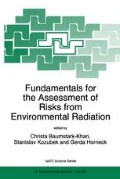Abstract
The frequency and types of chromosome aberrations in lymphocyte culture of peripheral blood of 24 cosmonauts have been studied. It has been ascertained that the yields of aberrant cells and of chromosome-type aberrations increase after long-term space missions. Proceeding from the linear-quadratic relationship between the effect on dose of high-energy protons, a calibration curve has been obtained after exposure of blood samples in vitro. There was a good agreement between individual doses of space radiation and appropriate doses of 9-GeV protons. It has been concluded that relatively low doses of space radiation result in instability of genome, which, in its turn, may be a cause of an increase in risks of development of the long-term consequences.
Access this chapter
Tax calculation will be finalised at checkout
Purchases are for personal use only
Preview
Unable to display preview. Download preview PDF.
References
Akatov U. A., Nevzgodina L.V., Sanovich V.A. et al. (1986) Radiation studies in space. Results of medical investigations onboard the station “Salute-6”-“Soyuz”, Nauka, Moscow, p.335–348.
Badhwar G.D., Konradi A., Atwell W. et al. (1996) Measurements of the Linear Energy Transfer Spectra on the Mir orbital station and Comparison with Radiation Tpansport Models, Radiat. Meas. 26 2, 147–158.
Bauchinger M, Schmid E., Dresp J. (1979) Calculation of the dose-rate dependence of the dicentric yield after Co-y-irradiation of human lymphocytes, Int. J. Radiat. Biol. 35 229–233.
Biological dosimetry: Chromosomal aberration analysis for dose assessment, IAEA, Vienna, Techn. Repts Ser., 260 (1986), 69p.
Bochkov N.P. (1971) Human chromosomes and irradiation, Atomizdat, Moscow. (Rus).
Bochkov N.P. (1993) A review of cytogenetical studies after Chernobyl accident, Vesnik RAMS, 6, 51–56. (Rus).
Fedorenko B.S., Savchenko N.Ya., Vorozhtsova S.V. et al. (1987) Biological effectiveness of helium ions and relativistic-energy protons, Radiobiology 27 3, 339–343. (Rus).
Gerasimenko V.N., Portman A.I., Bulanova M. et al. (1987) The influence of charged particles with relativistic energies on chromosomal aberration frequency in human blood lymphocytes (The dose-effect dependence and RBE values for deitrons and helium ions), Radiobiology 27 6, 743–747. (Rus).
Kudritsky Yu.K., Bikkulov R.I., Grigoryeva L.P. et al. (1974) Regularities of cytogenetical effects of ionizing radiations at low doses. Rept. Staatt Zentz. Strahlenschutz, 157 89–92.
Lloyd D.C., Edwards A.A. (1983) Radiation-induced chromosome damage in man, Alan R. Liss Inc., New York, 23–49.
Moorhead P.S. Novell P.S., Wellimann W.J. et al. (1960) Chromosome preparation of leucocytes cultured from peripheral blood, Exptl. Cell Res. 20 3, 613–616.
Nguen V.D. et al. (1991) Real time quality factor and dose equivalent meter “Circe” and its use on board the soviet orbital station “Mir”, Acta Astronautica 23 217–226.
Sevan’kaev A.V. (1987) Radiosensitivity of human lymphocyte chromosomes during mitotic cycle. Energoatomizdat, Moscow. (Rus.).
Stavitsky R.V., Ermakov I.A., Lebedev L.A. et al. (1989) Equivalent doses in human organs and tissues under X-ray procedures. Energoatomizdat, Moscow. (Rus.).
Author information
Authors and Affiliations
Editor information
Editors and Affiliations
Rights and permissions
Copyright information
© 1999 Springer Science+Business Media Dordrecht
About this chapter
Cite this chapter
Fedorenko, B.S., Petrov, V.M., Druzhinin, S.V. (1999). Chromosome Damages in Cosmonauts’ Blood Lymphocytes as a Measure of Radiation Effect. In: Baumstark-Khan, C., Kozubek, S., Horneck, G. (eds) Fundamentals for the Assessment of Risks from Environmental Radiation. NATO Science Series, vol 55. Springer, Dordrecht. https://doi.org/10.1007/978-94-011-4585-5_25
Download citation
DOI: https://doi.org/10.1007/978-94-011-4585-5_25
Publisher Name: Springer, Dordrecht
Print ISBN: 978-0-7923-5668-4
Online ISBN: 978-94-011-4585-5
eBook Packages: Springer Book Archive

